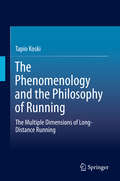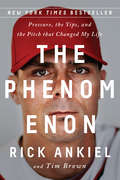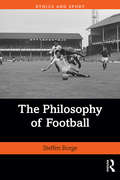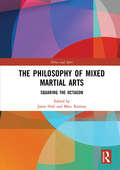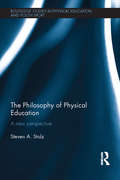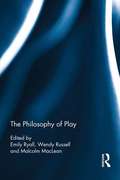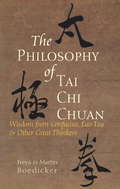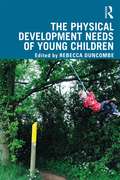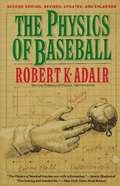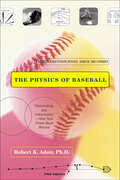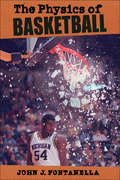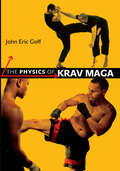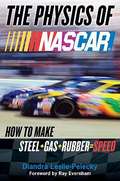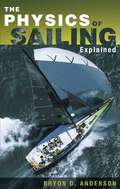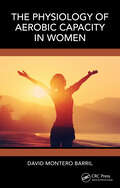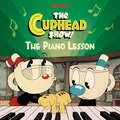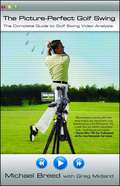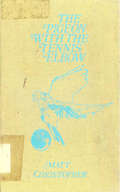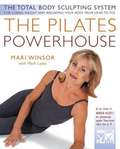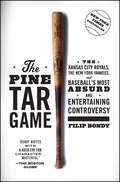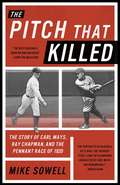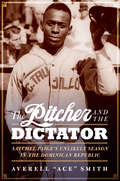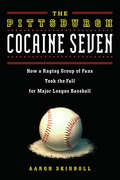- Table View
- List View
The Phenomenology and the Philosophy of Running
by Tapio KoskiThis book describes and analyzes the levels of experience that long-distance running produces. It looks at the kinds of experiences caused by long-distance running, the dimensions contained in these experiences, and their effects on the subjective life-world and well-being of an individual. Taking a philosophical approach, the analysis presented in this book is founded on Maurice Merleau-Ponty´s phenomenology of the body and Martin Heidegger´s fundamental ontology. Running is a versatile form of physical exercise which does not reveal all of its dimensions at once. These dimensions escape the eye and are not revealed to the runner conceptually, but rather as sensations and emotions. Instead of concentrating on conceptual analysis, this book explores the emotions and experiences and examines the meaning that running has in runners´ lives. Using the participative method, in which the author is both the research subject and the researcher, the book contributes to the philosophy of physical exercise.
The Phenomenon: Pressure, The Yips, And The Pitch That Changed My Life
by Rick AnkielRick Ankiel had the talent to be one of the best pitchers ever. Then, one day, he lost it.The Phenomenon is the story of how St. Louis Cardinals prodigy Rick Ankiel lost his once-in-a-generation ability to pitch--not due to an injury or a bolt of lightning, but a mysterious anxiety condition widely known as "the Yips." It came without warning, in the middle of a playoff game, with millions of people watching. And it has never gone away.Yet the true test of Ankiel's character came not on the mound, but in the long days and nights that followed as he searched for a way to get back in the game. For four and a half years, he fought the Yips with every arrow in his quiver: psychotherapy, medication, deep-breathing exercises, self-help books, and, eventually, vodka. And then, after reconsidering his whole life at the age of twenty-five, Ankiel made an amazing turnaround: returning to the Major Leagues as a hitter and playing seven successful seasons.This book is an incredible story about a universal experience--pressure--and what happened when a person on the brink had to make a choice about who he was going to be.
The Phillies Fan's Little Book of Wisdom
by Sue PorembaThe Phillies Fan's Little Book of Wisdom is chock full of quotes, humor, facts, figures, and memories about those fabulous Philadelphia Phillies.
The Philosophy of Football (Ethics and Sport)
by Steffen BorgeHuman beings are the only creatures known to engage in sport. We are sporting animals, and our favourite pastime of football is the biggest sport spectacle on earth. The Philosophy of Football presents the first sustained, in-depth philosophical investigation of the phenomenon of football. In explaining the complex nature of football, the book draws on literature in sociology, history, psychology and beyond, offering real-life examples of footballing actions alongside illuminating thought experiments. The book is organized around four main themes considering the character, nature, analysis and aesthetics of football. It discusses football as an extra-ordinary, unnecessary, rule-based, competitive, skill-based physical activity, articulated as a social (as opposed to natural) kind that is fictional in character, and where fairness or fair play – contrary to much sport ethical discussion – is not centre stage. Football, it is argued, is a constructive- destructive contact sport and, in comparison to other sports, is lower scoring and more affected by chance. The latter presents to its spectators a more unpredictable game and a darker, more complex and denser drama to enjoy. The Philosophy of Football deepens our understanding of the familiar features of the game, offering novel interpretations on what football is, how and why we play it, and what the game offers its followers that makes us so eagerly await match day. This is essential reading for anybody with an interest in the world’s most popular game or in the philosophical or social study of sport.
The Philosophy of Mixed Martial Arts: Squaring the Octagon (Ethics and Sport)
by Jason HoltMixed martial arts (MMA)—unarmed fighting games permitting techniques derived from a variety of martial arts and combat sports— has exploded from the fringes of sport into a worldwide phenomenon, a sport as controversial as it is compelling. This is the first book to pay MMA the serious philosophical attention it deserves. With contributions from leading international scholars of the philosophy of sport and martial arts, the book explores topics such as whether MMA qualifies as a martial art, the differences between MMA and the traditional martial arts, the aesthetic dimensions of MMA, the limits of consent and choice in MMA and whether MMA can promote moral virtues. It also explores cutting-edge practical and ethical topics, including the role of gender in MMA, and the question of whether trans athletes should be allowed to compete in the women’s divisions. The contributors to this anthology take down, ground and pound, and submit many essential questions about this fascinating recent development in the culture of sport and spectacle. This is important reading for anybody with an interest in combat sports, martial arts, or the philosophy, sociology, culture or history of sport.
The Philosophy of Physical Education: A New Perspective (Routledge Studies in Physical Education and Youth Sport)
by Steven A. StolzThe discipline area of physical education has historically struggled for legitimacy, sometimes being seen as a non-serious pursuit in educational terms compared to other subjects within the school curriculum. This book represents the first attempt in nearly thirty years to offer a coherent philosophical defence and conceptualisation of physical education and sport as subjects of educational value, and to provide a philosophically sound justification for their inclusion in the curriculum. The book argues that rather than relegating the body to “un-thinking” learning, a person’s essential being is not confined to their rationality but involves an embodied dimension. It traces the changing conceptions of the body, in philosophy and theology, that have influenced our understanding of physical education and sport, and investigates the important role that embodiment and movement play in learning about, through and in physical education. Physical education is defended as a vital and necessary part of education because the whole person goes to school, not just the mind, but the thinking, feeling and acting facets of a person. It is argued that physical education has the potential to provide a multitude of experiences and opportunities for students to become aware of their embodiment, explore alternative modes of awareness and to develop insights into and new modes of being not available elsewhere in the curriculum, and to influence moral character through the support of a moral community that is committed to that practice. Representing a sophisticated and spirited defence of the educational significance and philosophical value of physical education and sport, this book will be fascinating reading for any advanced student or researcher with an interest in physical education, the philosophy of sport or the philosophy of education.
The Philosophy of Play
by Emily Ryall Wendy Russell Malcolm MacLeanPlay is a vital component of the social life and well-being of both children and adults. This book examines the concept of play and considers a variety of the related philosophical issues. It also includes meta-analyses from a range of philosophers and theorists, as well as an exploration of some key applied ethical considerations. The main objective of The Philosophy of Play is to provide a richer understanding of the concept and nature of play and its relation to human life and values, and to build disciplinary and paradigmatic bridges between scholars of philosophy and scholars of play. Including specific chapters dedicated to children and play, and exploring the work of key thinkers such as Plato, Sartre, Wittgenstein, Gadamer, Deleuze and Nietzsche, this book is invaluable reading for any advanced student, researcher or practitioner with an interest in education, playwork, leisure studies, applied ethics or the philosophy of sport.
The Philosophy of Tai Chi Chuan
by Freya Boedicker Martin BoedickerThe essence of Tai Chi Chuan lies in the rich philosophy of ancient China. While most Tai Chi practitioners are aware of the value that studying Chinese philosophy can bring to their practice, it is often difficult to pick out those texts that are most relevant to Tai Chi and connected to its development. The Philosophy of Tai Chi Chuan presents, for the first time, a concise overview of the Chinese martial and spiritual philosophies that drive this ancient tradition.Authors Freya and Martin Boedicker, who teach Tai Chi throughout Europe and South Africa, present freshly translated excerpts from such popular and widely studied works as the Tao Te Ching, the I Ching, and The Art of War, as well as writings by philosophers and strategists such as Zhuangzi and Wuzi. Each chapter of this concise volume focuses on a single work or philosopher, and includes a short history of each one as well as a description of their relevance to Tai Chi. An extensive glossary of important Chinese terms rounds out the book. The Philosophy of Tai Chi Chuan offers readers a direct connection with the concepts that form the foundation of Tai Chi, inspiring a deeper understanding of the art and its applications.From the Hardcover edition.
The Physical Development Needs of Young Children
by Rebecca DuncombeWith growing concerns over declining levels of school readiness and physical activity, this book highlights the importance of quality early movement experiences and explores the connection between poor early Physical Development opportunities and later difficulties in the classroom. The book outlines the Physical Development needs of babies, toddlers and young children up to the age of eight, and suggests practical ways in which these can be provided for. It explores key concepts and terms, such as physical literacy, fundamental movement skills, sport, physical activity and Physical Education (PE), in relation to young children’s Physical Development needs and discusses age-appropriate provision. Advice is given to prevent movement difficulties from occurring, but it is acknowledged that not all children follow a typical Physical Development pathway, and, where this is the case, suggestions are provided to help put children "back on course." The Physical Development Needs of Young Children is important reading for all who work with or care for young children, including Early Years practitioners, primary school teachers, students who are studying to join these professions, and parents.
The Physics of Baseball
by Robert K. AdairScads of interesting facts about baseball as well as the physical laws of the game.
The Physics of Baseball: Third Edition, Revised, Updated, and Expanded
by Robert K. AdairA “fascinating and irresistible” blend of science and sports that reveals what a baseball (or bat, or player) in motion does—and why (The New York Times Book Review).How fast can a batted ball go? What effect do stitch patterns have on wind resistance? How far does a curveball break? Who reaches first base faster after a bunt, a right- or left-handed batter? The answers are often surprising—and always illuminating.This newly revised third edition considers recent developments in the science of sport such as the neurophysiology of batting, bat vibration, and the character of the “sweet spot.” Faster pitchers, longer hitters, and enclosed stadiums also get a good, hard scientific look to determine their effects on the game.Filled with anecdotes about famous players and incidents, The Physics of Baseball provides fans with fascinating insights into America’s favorite pastime.“Delivers scads of interesting facts.” —The Wall Street Journal
The Physics of Basketball
by John J. FontanellaDrain three pointers, slam dunk easily, and sink that buzzer beater from half court with the help of simple science. Your coach, physicist John J. Fontanella, shows how you can improve your game if you take advice from Isaac Newton. As you read, relive some of the great moments in the game—this time with a scientist and diehard basketball fan as your color analyst. Find out why you ought to put spin on the ball. Get tips on how to improve your free throw and increase your percentage from the charity stripe. You’ll even learn how to shatter the backboard, if that’s something you’ve always dreamed of doing. With photographs and simple high school formulas, physics professor Fontanella—who played in college against Pittsburgh and Syracuse—reveals the key pieces of physics that underscore basketball. He covers almost every aspect of the game, weaving in stories from games he’s played and games he’s seen, and tales from basketball history and folklore. Physics comes alive as you see how Kobe Bryant, Wilt "the Stilt" Chamberlain, Michael Jordan, Becky Hammon, and J. J. Reddick do naturally the things that Isaac Newton says they should.
The Physics of Krav Maga
by John Eric GoffThe art and science of real-world fighting. Explore the physics behind the physical!Krav Maga ("contact combat" in Hebrew) is a hard-hitting and efficient form of self-defense that was popularized by Israeli soldiers. Stressing practical, real-world fighting and a philosophy of self-defense, its popularity has grown worldwide over the past few decades. In The Physics of Krav Maga, John Eric Goff, a physicist, best-selling author, and martial arts practitioner, explains the science behind dozens of Krav Maga moves, from headlocks to hammer fists. Focusing on Warrior Krav Maga, a fighting style that combines the key elements of Krav Maga with kickboxing, wrestling, karate, and other fighting specialties, this equation-free, conceptual introduction is aimed at martial arts practitioners interested in refining their fighting technique and all fans of the fascinating moment when sports meet science.With step-by-step descriptions and detailed photos of each critical motion, Goff takes a scientific look at everything from punch speed to power output and reaction time. Armed with this book, readers will understand the physics behind each move. They will also learn how to• enhance their level of physical fitness• disrupt an opponent's balance—while keeping theirs• make use of leverage to defeat a larger, stronger attacker• become faster and more powerful• inflict pain up close• use weapons—and "weapons of opportunity"• and much more!Anyone interested in martial arts, in how physics applies to sports and combat, and in how a physicist wins a fight will love The Physics of Krav Maga.
The Physics of Nascar®
by Diandra Leslie-PeleckyA physicist explores the science of speed racing With 75 million fans, NASCAR is the #1 spectator sport in America. Now, in The Physics of NASCAR, a scientist explains the intricate and complex way the sport works, in terms that anyone who drives a car?or maybe occasionally looks under the hood?can easily comprehend. Based on her extensive access to NASCAR race shops, drivers, crew chiefs, engine builders, and pit crews during races, Diandra Leslie-Pelecky traces the life cycle of a race car from its creation at top race shops to competing in the door-todoor action of the NASCAR Sprint Cup Series. .
The Physics of Sailing Explained
by Bryon D. AndersonWhat is the best shape for a sailboat? How does turbulence affect a sailboat's movement through the water? Why do some keels have wings? Is it true that some sailboats can sail faster upwind than downwind?Authoritative yet accessible, The Physics of Sailing Explained is the perfect book for all those sailors who want to enhance their understanding and enjoyment of life at sea. It will enable cruisers and racers alike to better grasp how sails, keels, and hulls work together to keep boats afloat, and will sharpen their skills with a more subtle and thorough appreciation of why various boat design features are present and why certain tactics work in certain situations. Anderson outlines the science behind sailing in a way that anyone can understand and benefit from without having to trudge through a physics text or became a naval architect. Concepts are conveyed simply, concisely, and with many examples and illustrations.With the help of this invaluable book, sailors will be better prepared to handle any situations that might arise on the water.
The Physiology of Aerobic Capacity in Women
by David Montero BarrilThis book questions the limitation of exercise capacity in women by discussing female physiology from the perspectives of respiratory, circulatory, skeletal, body composition, and training adaptations. Written in a compelling manner, the book covers not only gender differences in exercise physiology but also touches upon such questions as doping and novel mechanisms in exercise theory and practice. Based on first-hand research experience, this book offers new and realistic perspectives, including positive and negative aspects of women’s capacity to perform exercise, which should interest the readers of kinesiology, integrative physiology, clinical science, general science and sociology of sports topics.Key Features: Research-based findings on the cutting-edge topic of women's aerobic capacity Written in an accessible manner and packed with science-based insights Presents an overarching view of various medical disciplines that are essential in evaluating women's aerobic capacity
The Piano Lesson (Pictureback(R))
by Billy WrecksIt's music and laughs galore as Cuphead and Mugman tickle the ivories in this full-color retelling of the "Piano Lesson" from Netflix's hit animated series The Cuphead Show!The Cuphead Show! follows the adventures of two lovable brothers—Cuphead and Mugman—through their unique misadventures! But no matter what the trouble is, they&’ve always got one another&’s backs. But what happens when Mugman's dream of becoming a great pianist is dashed by an unexpected musical genius? Fans of the Netflix animated series or the video game that inspired it, will love this retelling with full-color images straight from the laugh out loud series!
The Picture-Perfect Golf Swing: The Complete Guide to Golf Swing Video Analysis
by Michael BreedVideo swing analysis revolutionized the way golf is taught, but players have had to rely on teaching professionals to analyze their swing videos -- until now. The Picture-Perfect Golf Swing is the first-ever complete guide to using a digital video camera to develop the perfect golf swing, on your own. One of Golf Magazine's Top 100 Teachers, Michael Breed has long used video analysis to correct the swings of his students. At the core of Breed's teaching approach is the idea that seeing is believing: when you actually see the flaws of your swing, you can truly understand what you are doing wrong, and you can fix the problem more quickly and effectively. By using this book, golfers won't have to rely on professionals to tell them what they're doing wrong -- they can see it for themselves. The Picture-Perfect Golf Swing offers practical guidance for analyzing, assessing, and correcting your mistakes just like a professional -- but without paying a professional rate. Whether as a complement to swing analysis software or on its own, The Picture-Perfect Golf Swing is a must-have tool for everyone using digital video to master their swing. Fully illustrated with photographs showing fundamentally sound swing mechanics, the book also includes instructions on setting up a camera, choosing the best accessories for filming, selecting the correct shutter speed, using a remote control, and much, much more.
The Pigeon With the Tennis Elbow
by Matt ChristopherAt a tennis tournament, Kevin meets a talking pigeon who turns out to be his great uncle and gives him tennis tips.
The Pilates® Powerhouse: The Total Body Sculpting System For Losing Weight And Reshaping Your Body from Head to Toe
by Mari Winsor Mark LaskaAn exercise routine embraced by professional dancers for over fifty years, Pilates is now the hottest and most talked about fitness trend since the running shoe. The perfect blend of Yoga and Nautilus, Pilates concentrates on building strength and flexibility, improving coordination, balance, and posture, and increasing stamina. All Pilates movements are initiated by muscles in the abdominal area (known as the powerhouse) and are designed to work the smaller muscles that support larger ones, while stretching and lengthening the entire muscular package. A low-impact yet highly intense workout, Pilates is ideal for everyone, young or old, those who are extremely fit or out of shape, as well as those who have chronic pain, injuries, or asthma. Illustrated with over 100 black-and-white photographs, The Pilates Powerhouse brings this time-efficient and highly effective means to get and stay in shape into the home, without the need for expensive classes and elaborate equipment. Using only a mat, a stick and, for advanced Pilates, a ball, readers will feel personally trained by Mari Winsor's innovative routines and spirited instruction, reaping the dramatic and lasting results of Pilates in less than an hour a day.
The Pine Tar Game: The Kansas City Royals, the New York Yankees, and Baseball's Most Absurd and Entertaining Controversy
by Filip BondyThe New York Times bestseller—“a rollicking account” (The Kansas City Star) of the infamous baseball game between the Yankees and Royals in which a game-winning home run was overturned and set off one of sports history’s most absurd and entertaining controversies.On July 24, 1983, during the finale of a heated four-game series between the dynastic New York Yankees and small-town Kansas City Royals, umpires nullified a go-ahead home run based on an obscure rule, when Yankees manager Billy Martin pointed out an illegal amount of pine tar—the sticky substance used for a better grip—on Royals third baseman George Brett’s bat. Brett wildly charged out of the dugout and chaos ensued. The call temporarily cost the Royals the game, but the decision was eventually overturned, resulting in a resumption of the game several weeks later that created its own hysteria. The game was a watershed moment, marking a change in the sport, where benign cheating tactics like spitballs, Superball bats, and a couple extra inches of tar on an ash bat, gave way to era of soaring salaries, labor strikes, and rampant use of performance-enhancing drugs. In The Pine Tar Game acclaimed sports writer Filip Bondy paints a portrait of the Yankees and Royals of that era, replete with bad actors, phenomenal athletes, and plenty of yelling. Players and club officials, like Brett, Goose Gossage, Willie Randolph, Ron Guidry, Sparky Lyle, David Cone, and John Schuerholz, offer fresh commentary on the events and their take on the subsequent postseason rivalry. “A sticky moment milked for all its nutty, head-shaking glory” (Sports Illustrated), The Pine Tar Game examines a more innocent time in professional sports, and the shifting tide that resulted in today’s modern iteration of baseball. Some watchers of the Royals’ 2015 World Series win over New York’s “other baseball team,” the Mets, may see it as sweet revenge for a bygone era of talent flow and umpire calls favoring New York.
The Pitch that Killed: The Story of Carl Mays, Ray Chapman, and the Pennant Race of 1920,
by Mike SowellThis is the story of Ray Chapman of the Cleveland Indians, a popular player struck in the head and killed in August 1920 by a pitch thrown by Carl Mays of the New York Yankees. Was it, as most baseball observers thought at the time, a tragic but unavoidable accident? Mike Sowell's brilliant book investigates the incident and probes deep into the backgrounds of the players involved and the events that led to one of baseball's darkest moments.
The Pitcher Who Went Out of His Mind
by Dan GutmanThis is about a boy named Robert Newton who plays baseball along with his two best friends Manny and Lucy for the Sedona Red Rocks. While playing against the Vortex, Robert is "in the zone" when Simon Foster steps up to bat and Rob is about to pitch.
The Pitcher and the Dictator: Satchel Paige's Unlikely Season in the Dominican Republic
by Averell Ace" SmithSoon after Satchel Paige arrived at spring training in 1937 to pitch for the Pittsburgh Crawfords, he and five of his teammates, including Josh Gibson and Cool Papa Bell, were lured to the Dominican Republic with the promise of easy money to play a short baseball tournament in support of the country’s dictator, Rafael Trujillo. As it turned out, the money wasn’t so easy. After Paige and his friends arrived on the island, they found themselves under the thumb of Trujillo, known by Dominicans for murdering those who disappointed him. In the initial games, the Ciudad Trujillo all-star team floundered. Living outside the shadow of segregation, Satchel and his recruits spent their nights carousing and their days dropping close games to their rivals, who were also stocked with great players. Desperate to restore discipline, Trujillo tapped the leader of his death squads to become part of the team management. The American players believed they might be lined up and shot if they lost the tournament. When Paige’s team ultimately rallied to win, it barely registered with Trujillo, who a few months later ordered the killings of fifteen thousand Haitians at the border between Haiti and the Dominican Republic. Paige and his teammates returned to the states to face banishment from the Negro Leagues, but ironically they barnstormed across America wearing their Trujillo All-Stars uniforms.The Pitcher and the Dictator is an extraordinary story of race, politics, and some of the greatest baseball players ever assembled, playing high-stakes baseball in support of one of the Caribbean’s cruelest dictators. For more information about The Pitcher and the Dictator, visit thepitcherandthedictator.com.
The Pittsburgh Cocaine Seven: How a Ragtag Group of Fans Took the Fall for Major League Baseball
by Aaron SkirbollEerily prescient of times to come, this exposé examines drug use in Major League Baseball (MLB) during the mid-1980s and one of the biggest drug trials in baseball history. Through a series of exclusive interviews with FBI agents, U.S. attorneys, defense lawyers, journalists, former baseball executives, physicians, and the dealers themselves, the narrative provides a behind-the-scenes look into how the players managed their habits, the effect of the drugs on their athletic performance, and the ruses the players concocted to keep their drug consumption from becoming public knowledge. Among the all-stars implicated as cocaine users were Joaquin Andujar, Dusty Baker, Dale Berra, Keith Hernandez, Lee Mazzilli, John Milner, Dave Parker, and Lonnie Smith, while Willie Mays and Willie Stargell were fingered as amphetamine users. In addition to identifying the players involved, this account reveals how the hapless group of mostly diehard Pittsburgh Pirates fans got into cocaine and connected with the players as well as the often comic "deals" that eventually got them busted. Then MLB Commissioner Peter Ueberroth's failure to implement a strict drug policy in the aftermath of the trial is also discussed, along with the role this inaction played in enabling the steroid era.
